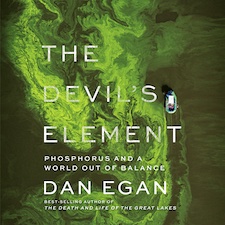
By Dan Egan
W. W. Norton, 2023
256 pages, hardcover, $30
“The Devil’s Element” is a timely introduction to the nuance and complexity of the issue of phosphorus and its impacts — and should be a wake-up call for eco-conscious readers. With a biting wit and human-focused storytelling, author Dan Egan masterfully illustrates how the connection between phosphorus and human society is one of constant balance between innovation and destruction, from the first recorded uses of phosphorus to the present day.
Phosphorus has revolutionized the efficiency and scale of modern agriculture, but its present mismanagement is poisoning our waters without cheap or easy solutions. Egan deftly weaves the history of phosphorus through human history, from ancient people discovering the usefulness of bone and manure in agriculture, to the Incas of Peru using guano, to the bone robbers of the Battle of Waterloo, to conflicts in the Western Sahara.
As he moves through the past, present and potential future of the complex interaction between phosphorus, human society and the surrounding environment, Egan’s central goal is to make the information comprehensible and readable. “The Devil’s Element” is detailed, but economical; the threads of the story that Egan manages to tie together reach far out into time and space while remaining undeniably digestible. He is a master of pithy one-liners and hilariously horrifying descriptions, like the “guacamole-thick” toxic algae choking waterways spanning the United States.
He has a knack for finding and choosing bizarre anecdotes and sources, including a professor at Johns Hopkins who conducts ancient chemical experiments (and strongly advised Egan against doing certain ones himself) and a Florida man who almost died from phosphorus exposure while trying to escape the police. These anecdotes are wryly funny, but Egan brings a stark humanity to “The Devil’s Element,” too, through his one-on-one interactions with people immediately faced with the negative impacts of phosphorus pollution, from a woman trying to save her precious Lake Eerie to a Florida beach vacationer weighing the risk of dipping her toes into toxic blue-green algae.
Egan’s sections about the role that farmers play in the phosphorus crisis, particularly in the Midwest, is nuanced but bleak. His interviews with reluctant farmers in that area show they are often not spreading phosphorus-rich fertilizer to grow food, but corn for ethanol. Egan makes it clear that most farmers who are contributing to the crisis don’t know how to stop using phosphorus in a way that damages the local environment, which can be a frustrating removal of agency, but also illustrates the need for top-down approaches to solve the crisis.
Though Egan is clear-eyed about the challenge presented by the phosphorous paradox, the solutions he presents can feel muddled. There are a few loose ends, but Egan aptly attempts to close the loop on the phosphorus story by talking about innovations in treating manure, recycling urine and processing waste. He recognizes that most of these solutions are in their infancy, but the discussion leaves the reader with a sense of hope that maybe if we put our minds to it, we can stop poisoning the planet and feed humanity, all at the same time.
Sam Schipani, Bangor, Maine

